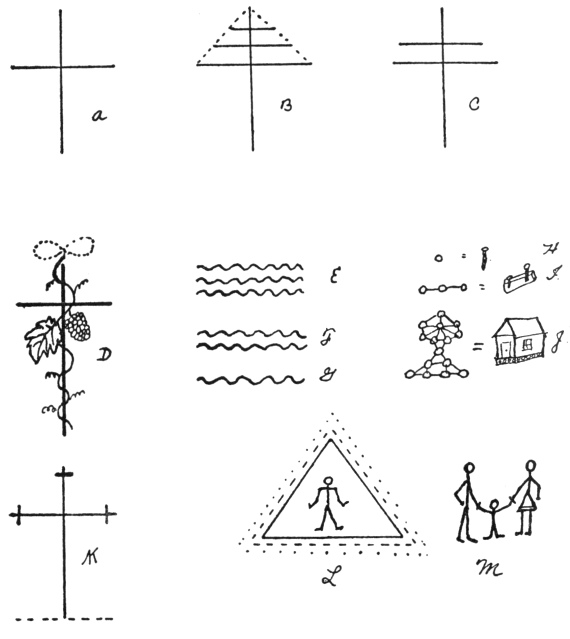
[back]

SYMBOLS AND THEIR
HUNA SIGNIFICANCES
A. The cross as an ancient symbol of the low or subconscious self or spirit of
man. The central line represents the physical body. The cross bar represents (1)
the low self, (2) the shadowy body of the low self, and (3), the low voltage of
vital force.
B. The cross with three bars was a symbol much used in ancient Egypt and later became the "Pope's Cross" of the Church of Rome. Its three bars represent the three selves of man, the three shadowy bodies used by the three selves and the three voltages of vital force used by the three selves. The dotted lines show how the formation gives also the triangle as a symbol of the same thing, but leaving out the center shaft of the cross, therefore symbolizing the state after death when the physical body is gone.
C. The cross with two bars represents the low and middle selves of man, also their shadowy bodies and two voltages of vital force. ("Cardinal's Cross" of the Church of Rome, as the single bar cross is the "Priest's Cross.") (The Greek Catholic Church uses a cross designed after the fashion of drawing K.)
D. The vine climbing up a cross (one bar), symbolizes the rising of the low voltage vital force of the low self to the High Self, here shown as a combined-duality in dotted lines above the cross. The leaf is to identify the vine as a vine and not a serpent, the latter not being a symbol of vital force because a serpent cannot split or branch out into three branches to symbolize the three voltages of vital force. The cluster of grapes or berries on the climbing vine represents the cluster of thought forms of a prayer, being carried, figuratively, up to the High Self on the ascending vital force or vine.
E. Vital force was also symbolized as water. Three waves are used here to indicate the high voltage of vital force used by the High Self.
F. The middle voltage of vital force used by the middle or conscious self.
G. The low voltage of vital force used by the low self and supplied to the middle and High Selves to be raised in voltage and used by them.
H. A pictorial representation of a single thought form of a nail.
I. Three associated thought forms of a board and two nails.
J. A large and complicated association of the thought forms that represent a house. It is a complicated "cluster" like this that is pictured as the grape cluster in drawing D.
K. Three crosses on the tips of the one-barred cross furnish a symbol to represent the three selves, the three shadowy bodies, the three voltages of vital force, and the physical body, all combined to represent a living man.
L. The triangle is similar in meaning to the three-barred cross if each side may be considered to represent three parts of the man, as the three selves for one side, the three shadowy bodies for another, and the three vital forces for the last. The figure of a man drawn inside the triangle is placed there to indicate the physical body, which is the base of the other nine elements during physical life.
M. The Father, Mother and child symbology is very ancient. In Huna it is to be seen in the idea that the High Self is a united-but-separate parental pair, the child being the lesser man composed of a low and middle self.